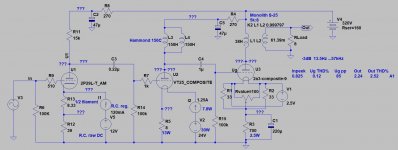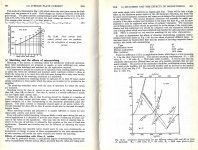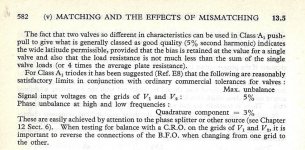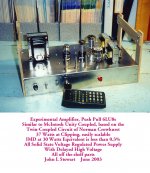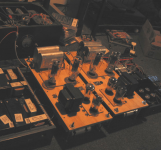Do you thought to use 10Y as cathode follower?I could build a 3 stage 2a3 amp with 2P29L input and 10Y driver.
2P29L stage hasn't enough gain to drive 2A3.
Do you thought to use 10Y as cathode follower?
2P29L stage hasn't enough gain to drive 2A3.
??? I was talking about 3 gain stages. 2P29L > 10Y > 2a3. Or 10Y > 71A > 2a3 or whatever. All DHT. Very tedious to build all that, but as you know single DHT stages don't have enough gain by themselves.
An Adventure Into the Unknown!! 2A3 in PP with a 45.
Makes its own 2H distortion just like a WWl Biplane makes its own headwind!
But the performance NTL still looks reasonably good. The PP OPT forces symmetry just like it is supposed to do.
But there is a DC level shift, some people used to call that rectification.
It is the first term of the Fourier Series of this kind of unbalance, the 2nd term is 2H. And the 3rd term is 4H.
If an SE stage has level shifting as the average signal level changes that is an
indication of even order distortion, 2H, 4H, 6H & so on. 😀
Makes its own 2H distortion just like a WWl Biplane makes its own headwind!
But the performance NTL still looks reasonably good. The PP OPT forces symmetry just like it is supposed to do.
But there is a DC level shift, some people used to call that rectification.
It is the first term of the Fourier Series of this kind of unbalance, the 2nd term is 2H. And the 3rd term is 4H.
If an SE stage has level shifting as the average signal level changes that is an
indication of even order distortion, 2H, 4H, 6H & so on. 😀
Attachments
Classical pentode driver for 2A3 has several problems. First, low idle current (typically less than 1 mA) is inadequate to drive 2A3 to full power due to relatively high Miller capacitance causing RC and/or slew rate limitation of higher frequencies. Second, pentodes have intrinsic high frequency roll off dependent on load resistance (20,000 Hz for 100 K, but only 10,000 Hz for 250 K). Third, pentode is less efficient than triode in B+ voltage use in RC-coupled stage, badly limiting undistorted output voltage. For these reasons, I would avoid a classical pentode driver.
High current TV video pentodes do not have these problems. Would be an interesting type of driver to try.
High current TV video pentodes do not have these problems. Would be an interesting type of driver to try.
45 was the best driver sound-wise for a PP DHT stage, according to Lynn Olson.An Adventure Into the Unknown!! 2A3 in PP with a 45.
Makes its own 2H distortion just like a WWl Biplane makes its own headwind!
But the performance NTL still looks reasonably good. The PP OPT forces symmetry just like it is supposed to do.
But there is a DC level shift, some people used to call that rectification.
It is the first term of the Fourier Series of this kind of unbalance, the 2nd term is 2H. And the 3rd term is 4H.
If an SE stage has level shifting as the average signal level changes that is an
indication of even order distortion, 2H, 4H, 6H & so on. 😀
I was thinking about 6Э5П up to 10mA, burning almost 5W in a 47K RL and its PS would go up to double the final's B+ indeed.High current TV video pentodes do not have these problems. Would be an interesting type of driver to try.
There is an interesting tube for those who would like to experiment with different types of drivers. 6AG9 is a 12-pin compactron that has high current pentode section and medium mu triode section. The schematic above is for the 2A3 driver using the pentode section of 6AG9. As shown, voltage gain is about 55 and bias current is about 8 mA. Only the primary of the 1:1 interstage transformer, and the secondary of input transformer are shown. Of course, the circuit can be modified for RC coupling, cathode bias, and no-transformer input. Screen decoupling capacitor of 0.1 uF is sufficient.
The triode section of 6AG9 is equivalent to paralleled-section 6A6/6N7. Very linear.
Dirt cheap tube.
Last edited:
Sorry, my bad in previous post. Screen resistor should be 62 K, not 150 K, with minimal value of bypass capacitor 0.25 uF. Should have double checked before posting.
Pete Millett's testing suggest pentodes can be right in the hunt regarding output. If I'm reading 'Rl' correctly as plate load, wouldn't those small values also help ameliorate the Miller hurdle?pentode is less efficient than triode in B+ voltage use in RC-coupled stage, badly limiting undistorted output voltage.
Forgot link: http://www.pmillett.com/pentodes.htm
Yes, lower value plate load resistor will increase plate voltage (more output headroom) and reduce stage's output impedance, but at the cost of lower gain. Lowering load resistor from 200 to 100 K will reduce gain 2 times.Pete Millett's testing suggest pentodes can be right in the hunt regarding output. If I'm reading 'Rl' correctly as plate load, wouldn't those small values also help ameliorate the Miller hurdle?
Forgot link: http://www.pmillett.com/pentodes.htm
On the other hand, for minimal distortion, pentode voltage amplifying stage should have as much gain as practically possible. This is because pentode plate curves are spaced very unevenly, so that large input swings cause unacceptably high levels of second harmonic. From distortion point, a good pentode 2A3 driver should have gain of 300 and work with 0.1 Vrms input voltage. The operating point should be close to the bottom of the plate curve family - that's where plate curve spacing is most uniform. The same pentode set up for gain of 60 with 0.5 Vrms input will have better HF extension, but probably an order of magnitude more distortion.
As you can see, with a classic pentode driver you can have very low distortion at very high gain, but at the price of high frequency roll off. Or you can have good HF response, but at the price of higher distortion.
By many accounts, 6C6 pentode driving 2A3 or 300B sounds really nice. Many of us who are at their golden years (myself included) cannot hear beyond 10-12 kHz, and we listen at a small fraction of amplifier's full power. Under such circumstances, a classical pentode drive may be quite acceptable.
What is the function of the 5K resistor?View attachment 1085516
As shown, voltage gain is about 55 and bias current is about 8 mA. Only the primary of the 1:1 interstage transformer, and the secondary of input transformer are shown.
For DC conditions it does very little (assuming interstage primary resistance about 1K ohm). For AC conditions it is swamping amplification and giving a steeper load, resulting in higher distortion.
I did two projects using the 6LU8, a tube similar to the recommended 6AG9. One was PP 6LU8s in my take
of Crowhurst's Twin Coupled Amp. a poor mans version of a McIntosh UC circuit. It worked very well,
with 400V of B+ it clips at ~35 watts, And very good numbers for both THD & IMD..
The other is an SET or SEUL thing, that was OK too. While developing the amps I tried the 6LU8 in
SE Pentode, the results were so poor I didn't use the data as part of the final article,
Based on that observation the 6AG9 may not be a good choice as a driver,
Both articles were published in Glass Audio/AudioXpress. 😀
👍
of Crowhurst's Twin Coupled Amp. a poor mans version of a McIntosh UC circuit. It worked very well,
with 400V of B+ it clips at ~35 watts, And very good numbers for both THD & IMD..
The other is an SET or SEUL thing, that was OK too. While developing the amps I tried the 6LU8 in
SE Pentode, the results were so poor I didn't use the data as part of the final article,
Based on that observation the 6AG9 may not be a good choice as a driver,
Both articles were published in Glass Audio/AudioXpress. 😀
👍
Attachments
An amp finishing up on the bench runs a 6LU8 SE in pentode mode. CCS on the triode, 10K plate load on the pentode, 375 Vdc @ 35ma, GNFB. It sounds great to my ears, 0.35% distortion at 1 watt dominantly 2nd with 3rd around 0.03% and all remaining harmonics greater the 90 dB down. I think 5 watts peak under 1%. Even this ugly duckling can fly.I tried the 6LU8 in SE Pentode, the results were so poor I didn't use the data as part of the final article,
The GNF cleaned up the high order harmonics probably. Did you put a scope to the triode output?An amp finishing up on the bench runs a 6LU8 SE in pentode mode. CCS on the triode, 10K plate load on the pentode, 375 Vdc @ 35ma, GNFB. It sounds great to my ears, 0.35% distortion at 1 watt dominantly 2nd with 3rd around 0.03% and all remaining harmonics greater the 90 dB down. I think 5 watts peak under 1%. Even this ugly duckling can fly.
Undoubtedly. The driver was scoped and measured open loop. With the tube samples on hand (GE) and the input triode CCS loaded driving a 130K grid resistor it made enough voltage to clip the amp without exceeding 0.02% THD, almost all 2nd harmonic. The amps performance degrades significantly with a 5k pentode plate load so guessing it's a combination of a very good driver, a lightly loaded plate and low voltage (75 vdc) screen.
Indeed, DC is determined by resistance of transformer's primary. This way plate voltage is maximized (better utilization of B+). For AC, transformer is out of the way, so plate load is determined almost entirely by the resistor.What is the function of the 5K resistor?
For DC conditions it does very little (assuming interstage primary resistance about 1K ohm). For AC conditions it is swamping amplification and giving a steeper load, resulting in higher distortion.
Keeping resistor value low allows the use of commercially available interstage transformers.
As I discussed in my previous post, pentode distortion is largely determined by input signal level. For a given output swing, the lower the input and the higher the gain, the lower the distortion. In this circuit, gain can be increased by increasing idle current (pentode's Gm will double at 20 mA), or increasing load resistance (2× gain with 10 K resistor). With such measures, the gain will be over 200. However, interstage transformer use becomes problematic.
Then there is an issue of what to do with such high gain. Typical CD player output is 2 Vrms, but for gain of 200 the highest input signal is 150 mV.
Power pentode and voltage amplifier pentode are somewhat different beasts.I did two projects using the 6LU8, a tube similar to the recommended 6AG9. One was PP 6LU8s in my take
of Crowhurst's Twin Coupled Amp. a poor mans version of a McIntosh UC circuit. It worked very well,
with 400V of B+ it clips at ~35 watts, And very good numbers for both THD & IMD..
The other is an SET or SEUL thing, that was OK too. While developing the amps I tried the 6LU8 in
SE Pentode, the results were so poor I didn't use the data as part of the final article,
Based on that observation the 6AG9 may not be a good choice as a driver,
Both articles were published in Glass Audio/AudioXpress. 😀
👍
5k resistor across an interstage transformer, or output transformer, or plate choke.
Of course!
Transformer primaries and plate chokes may have low impedance at low frequencies, low impedance at high frequencies, and may be resonant at a mid frequency.
When they are driven by a high impedance Pentode, or Beam Power tube, the frequency response may fall off early at both the low frequencies, and the high frequencies; and there may be a resonant peak at mid frequencies.
That is the penalty of using high plate impedance tubes, less than perfect transformers or plate chokes, and a circuit that has no local negative feedback.
High voltage gain numbers is not always the only thing that you need from a Pentode or Beam Power tube.
Your Mileage May Vary
Of course!
Transformer primaries and plate chokes may have low impedance at low frequencies, low impedance at high frequencies, and may be resonant at a mid frequency.
When they are driven by a high impedance Pentode, or Beam Power tube, the frequency response may fall off early at both the low frequencies, and the high frequencies; and there may be a resonant peak at mid frequencies.
That is the penalty of using high plate impedance tubes, less than perfect transformers or plate chokes, and a circuit that has no local negative feedback.
High voltage gain numbers is not always the only thing that you need from a Pentode or Beam Power tube.
Your Mileage May Vary
Last edited:
This was my 01A > 71A > PP 2A3 with Buds IT and OPT, which ultimately became PSE 2A3 with UBT-1 OPT (3 stage DC) before being 'decomissioned'. With heating complexities, I was with a 45V 250mA CCS regulated supply and series heated the input and driver, then moved to SLA batteries to acccomodate a slightly different front end with 1:4 input (LL7903) and split rail supply.Or 10Y > 71A > 2a3 or whatever. All DHT. Very tedious to build all that, but as you know single DHT stages don't have enough gain by themselves.
Attachments
Last edited:
- Home
- Amplifiers
- Tubes / Valves
- Developing a 2A3 SET
